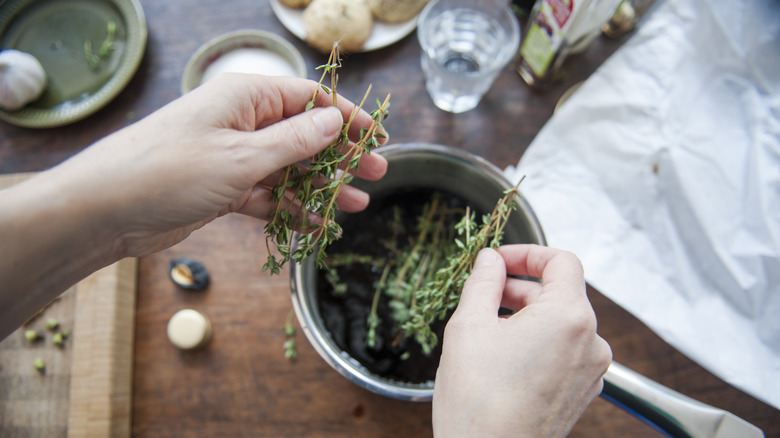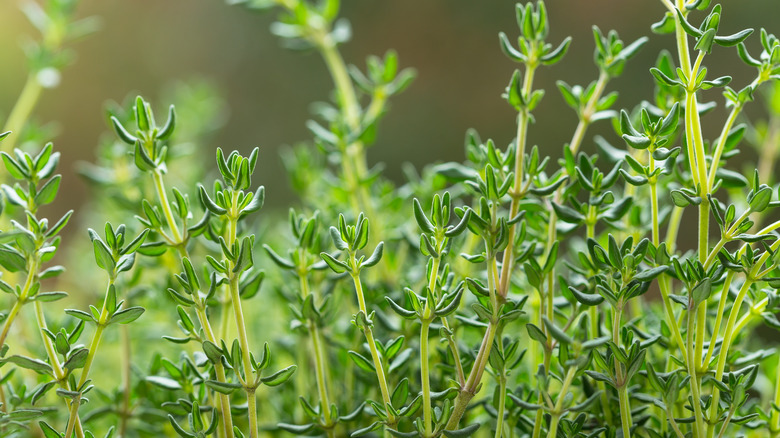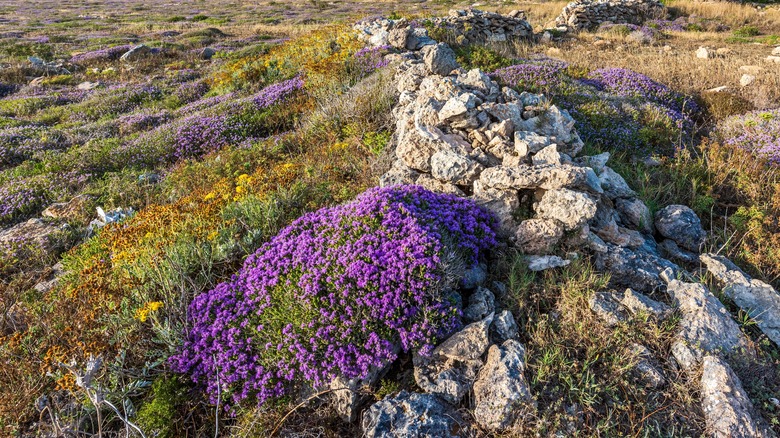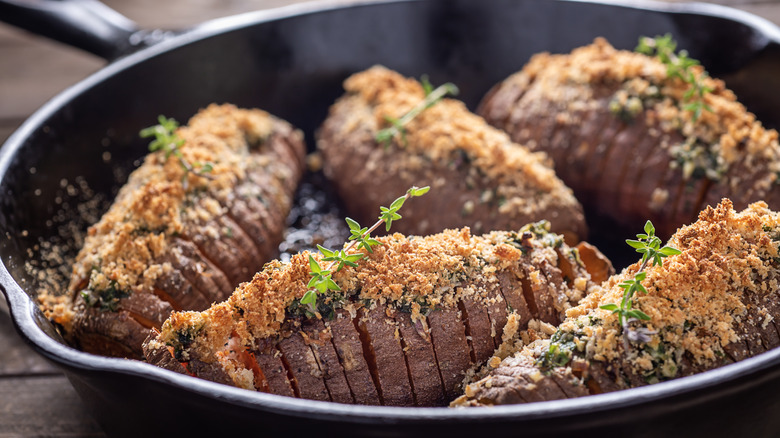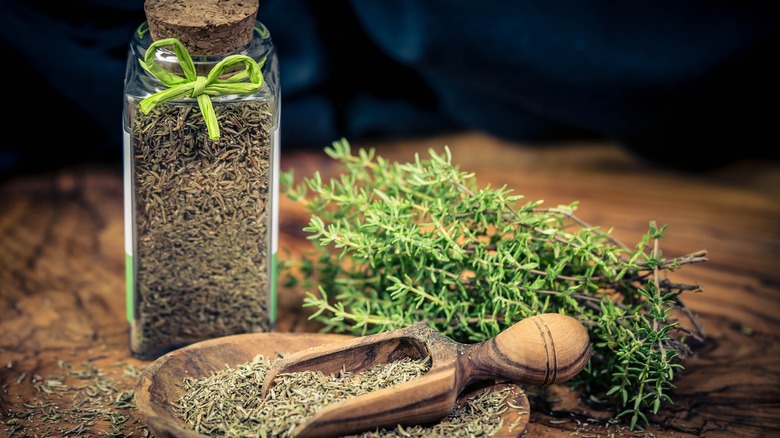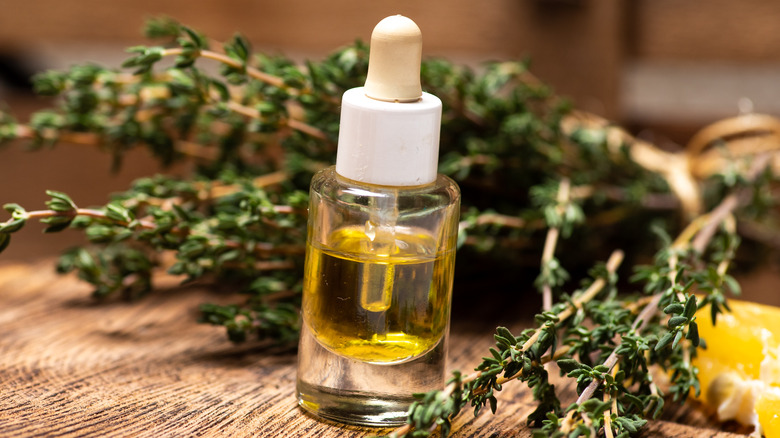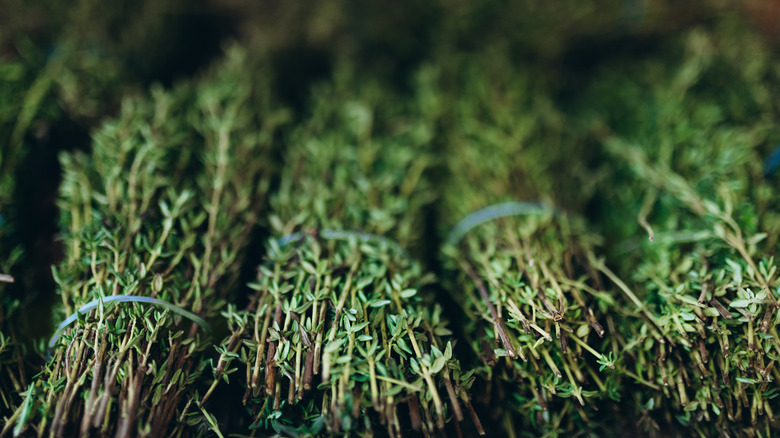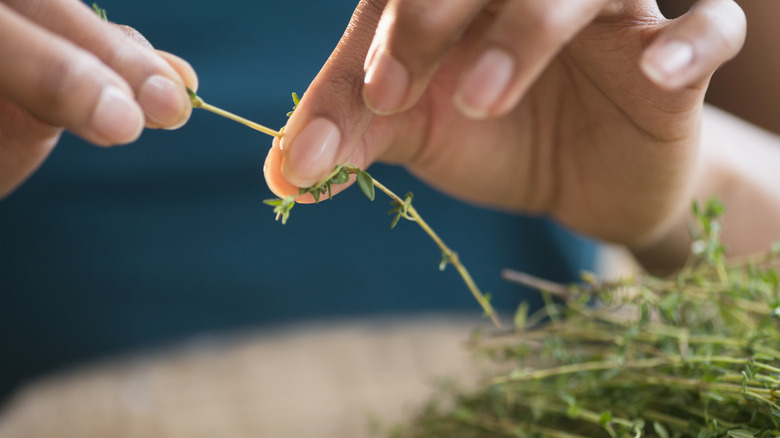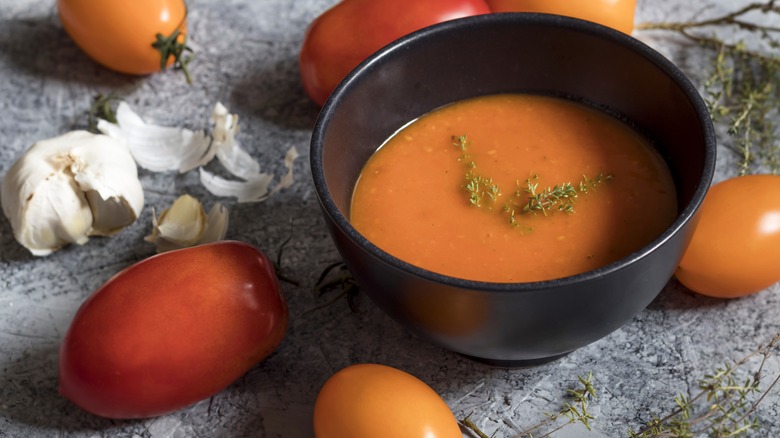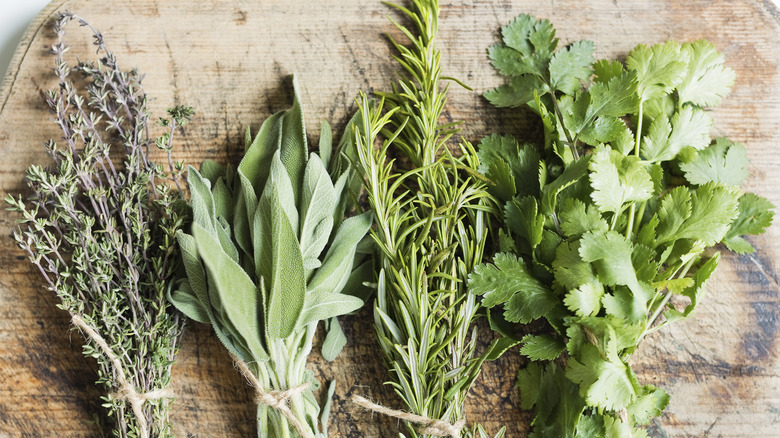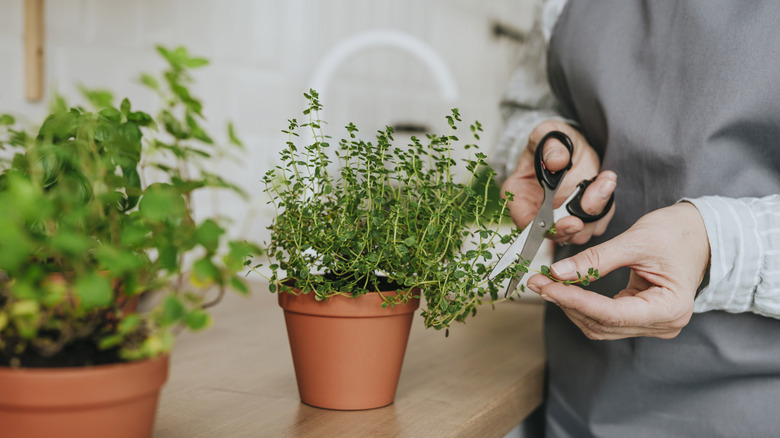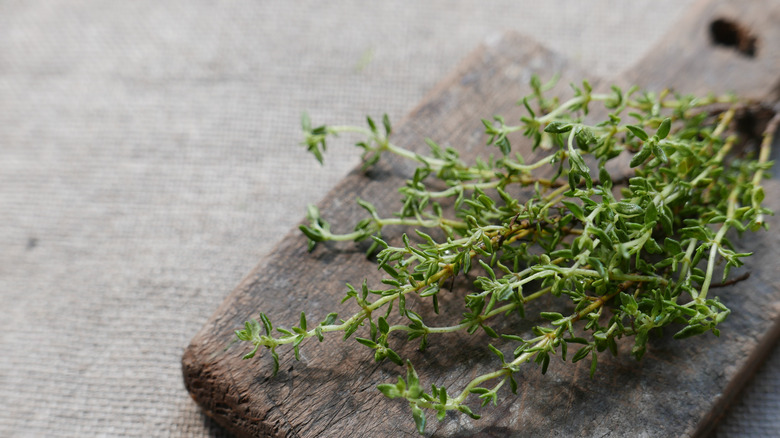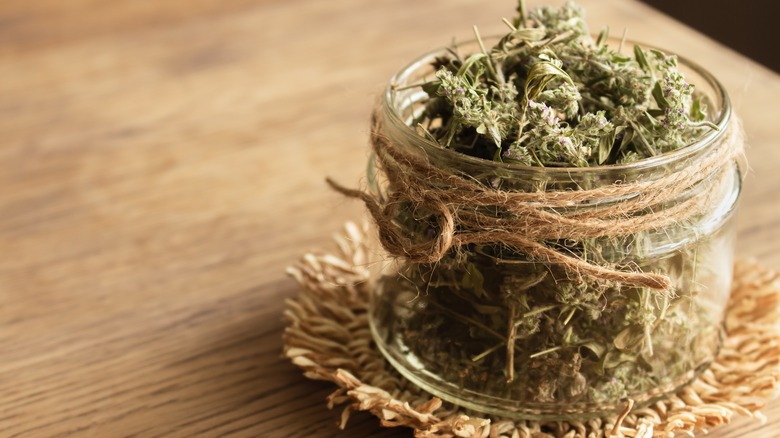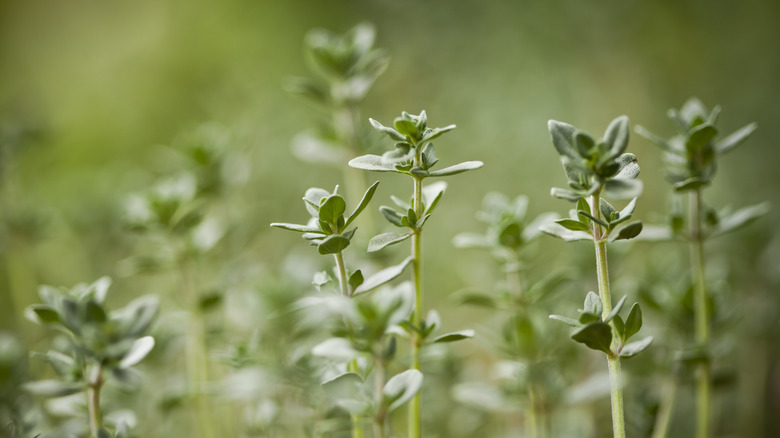The Everything Guide To Cooking With Thyme
Thyme is an ancient herb that grows in backyards across the temperate world. It's easy to cultivate and harvest, simple to use in the kitchen fresh or dried, and incredibly flavorful. Throw in a ton of health benefits and easy, long-lasting storage, it's really a crime not to have it on hand at all times.
Of course, most folks do have a jar of thyme on their spice rack. However, many home chefs are baffled by the fresh variety, which is much more flavorful than dried. Often, too, they are familiar with a few ways to use it (e.g., dump it into soup) but don't have a handle on all its uses: as part of a bouquet garni, a potato accompaniment, or even a cocktail ingredient.
This guide is here to help. By the time you're done, you'll know exactly what thyme is, how to source it properly and the many ways to use it. You'll also know how to grow it, should you have a gardener's predilection, as well as how to dry and store it. Without further ado, it's time for thyme.
What its thyme?
Thyme or common thyme (Thymus vulgaris) is a woody perennial herb that is easy to grow and easier to use in the kitchen. It has small, flavorfully herby leaves on long branching stems, which you can harvest at any time of the year. It is an evergreen that typically grows between 6 and 12 inches high and wide, though the wide variety of thyme cultivars offers the home gardener many options. Common thyme is, however, still the most popular garden variety (no pun intended).
Thyme's pungent aroma comes from thymol. This is the main component that gives potency to its essential oil and lends it the minty smell that betrays its membership in Lamiaceae, the mint family. This compound is what comes through when thyme is used to make liqueur, perfume, and various traditional culinary dishes. Close relatives include oregano, basil, lavender, rosemary, and of course, mint itself.
A brief history of thyme
Thyme has been with humanity for thousands of years. The wild variety still grows in the part of Eurasia known as the Levant, which includes Turkey, Jordan, Lebanon, Syria, and Israel/Palestine, indicating that this may be its birthplace.
Either way, by the time of the Ancients, thyme grew prolifically around the Mediterranean and Near East. It was used by the Egyptians as an embalming agent and by the Greeks as incense and bath aromatherapy. The enterprising and cosmopolitan Romans are likely responsible for spreading it throughout what would become Medieval and present-day Europe.
The modern name comes from the Greek word "thymos," which means courage or strength and referred to plants in today's Thymus or Satureja genera. Given its thousands of years of breeding across the world, it's no surprise that today thyme is available in more than 50 varieties. Thyme made its way to the Americas along with the first European settlers, who used it as both a culinary and medicinal herb.
What does thyme taste like?
The first answer to this question is another question: What does thyme smell like? The aroma of food influences its taste mightily, because without our sense of smell, we can only access the five basic tastes: sweet, salty, bitter, sour, and umami. It is smell that puts the puzzle together, which can manifest in tens or even hundreds of thousands of detectable ways in the human nose.
Thyme's strong but mild herbal smell is influenced by its variety (for instance, lemon thyme or caraway thyme), whether it's fresh or dried, and other factors, all of which come through in its flavor. Overall, though, it is minty and fresh, earthy and a little citrusy. It is also described as having a clove-like, spicy, and savory flavor. It often carries floral hints, the way lavender and rosemary do. Its mellow profile makes it the perfect companion to rich meats with buttery sauces, cooling soups, and bright summer drinks, all of which it complements without overwhelming.
Fresh versus dried thyme
Fresh and dried thyme offer such different benefits that they might almost be two different herbs. In general, fresh herbs are more delicate but less strongly flavored. That's because the scent compounds in dried herbs are non-volatile, meaning they will not evaporate when exposed to heat, unlike their freshly harvested brethren. This also means that because dried herbs are more strongly flavored, you only need about ⅓ of the amount you would use fresh.
The story is no different for thyme, no matter the variety. While both fresh and dried thyme share the same general profile described above, there are differences between the two. The aroma and flavor of fresh thyme are mild, sweet, and gently earthy. On the other hand, dried thyme tends toward the earthier but with a less intense, peppery flavor. Over time, however, all dried herbs lose their flavor. If you smell dried thyme that has little to no scent, that's not because the variety isn't worthwhile, but rather because the herbs are simply too old.
Available forms of thyme
Thyme, like many other Mediterranean herbs, is super versatile and widely available. There are many choices when it comes to the type of thyme: lemon, caraway, lavender, and juniper, among many others. You can get the widest variety at a nursery or online, whereas most of what you'll find at the grocery store is common or perhaps English or lemon thyme. Depending on your needs, you can find both fresh and dried thyme at the store.
Essential oils are yet another way you can get thyme scent and flavor, but you have to be careful with them, because they are extremely concentrated. In cooking, one drop of essential oil is equivalent to 2 teaspoons of dried thyme, so start very slowly and add more as you need to. Typically, you'll have to go to a specialty shop or herbalist to get good essential oils, though some co-ops and health food stores have them in stock. Ideally, you'll use the leaf rather than the oil when cooking, as it's easier to control.
How to choose the best herbs
Choosing herbs isn't rocket science, but if you're trying to up your culinary game, it helps to understand what you're looking for. The rules are different with fresh and dried herbs, and a few tips will help you prevent bringing home tasteless or soon-to-be rotten seasonings.
Dried thyme is available in the herbs section, where you should look for leaves that are still green (not gray) and within their sell-by date. Local herb suppliers will often net you fresher goods, more recently dried and with better flavor. However, they can be more expensive than larger companies, so it's a matter of preference.
When buying fresh thyme, head to the produce section, where you'll find it alongside the other fresh herbs, such as rosemary, sage, parsley, and cilantro. Make sure when selecting fresh herbs at the store that you choose bright green stems with healthy-looking leaves and bendable, not brittle, stems. If you're in a hurry and can't get to the store, you can even buy fresh bundles of picked leaves online.
Pulling thyme: a necessary skill
Many herbs are relatively easy to use. Think basil, cilantro, or parsley. Thyme? Not so much. If you don't know how to pick it correctly, fresh thyme just turns into a frustrating mess. Plus, if you don't prepare it right, you can end up with woody pieces in your soups and sauces, which is no one's idea of a good ... time.
To avoid this, start with fresh and washed sprigs of thyme, either from the garden or the store. First, remove any flowers or dead parts so that you have nice, green leaves left. Next, pinch the little bunch off the top of each stem for use. After you do that, turn the stem around and run your fingers backward down the branch to pull off the leaves. Counterintuitively, it helps to choose thicker stems so that the leaves come off more easily without breaking the stem.
If you don't want to fuss with removing the leaves and are making a cooked dish like soup or braised meat, you can just toss the whole sprigs into the pot. Just make sure to remove them before serving – the woody stems are not edible.
Using thyme in the kitchen
Thyme is so delicious that it's useful in almost any culinary tradition. It is common in Indian curries, African stews, Italian pastas, and foods from other cuisines. You can use it to give a minty, herbal zing to soups, stews, salads, dips, potatoes, braised and roasted meats, risottos, roasted veggies, and so much more. From tomato tarts to red wine braised short ribs, chicken pot pie to an herby loaf of bread, it's your savory ace in the hole.
It's also a wonderful secret ingredient for roasted potatoes. Truthfully, this writer wouldn't dream of roasting a batch of spuds without a sprinkling of salt, garlic powder, and either fresh or dried thyme. Simply cut the potatoes into 1-inch cubes, coat liberally with olive oil and seasonings, and cook at 425 F in a glass dish, uncovered, until crispy.
Flavoring desserts with thyme
Thyme isn't confined to the savory realm. For instance, betcha didn't think a strawberry pavlova could improve with the addition of some good old Thymus vulgaris, but as it so happens, it can. This airy-fairy dessert is proof positive that thyme is not a one-trick pony, combining a liberal amount of whipped cream with meringue, chopped fruit, and a minty, spicy zing courtesy of your new favorite herb.
Because it has such a light and floral flavor when fresh, you can use it in jams, lemon bars, and even cakes too. The trick is to use very fresh thyme with all the stems removed so that you get that light herbal flavor rather than the heavier sweetness of dried thyme. If you make a thyme-flavored dessert, it's always nice to garnish with fresh sprigs.
It's cocktail thyme!
Finally, the moment we've all been waiting for: how to use thyme at cocktail hour. There are many ways to do this. You might infuse liquor with thyme for a few days, make a simple syrup and add it to booze, or use fresh leaves and sprigs as a garnish. You can also use thyme to make mocktails or sparkling drinks for the summer patio.
Whatever you do, you'll want to use fresh herbs, which make for better bevies. That's as true for herb-elevated lemonade as it is for sparkling lemon-thyme cocktails or thyme-laced bourbon. Don't go getting too overwhelmed, though; there's time to make all three. For the first, you simply need to pick some fresh herbs and brew them up along with your lemonade, either by adding the simple syrup or by sprinkling in fresh herbs at the end. (It's fun to put herbs in ice rings, too.)
More interested in spiked libations? Try a combination of thyme-infused vodka, lemon juice, plain simple syrup, rhubarb bitters, prosecco, and an ice cube to a shaker. Mix it all up and pour it into a glass. Oh, and if you're going to use fresh herbs, make sure to slap them around a little — this is the way mixologists do to release their flavor.
Substitutes for thyme
Don't have thyme on hand? Not a problem; a number of other herbs can step into the breach without much fuss. The best options are those that have the same minty, Mediterranean flavor profile. Think oregano, sage, marjoram, tarragon, or rosemary. Basil also shares an aromatic palette with thyme, which is why they're both in Italian seasoning and it, in turn, can substitute for either.
Other herbal blends include Za'atar or Herbs de Provence, both of which include thyme, from the Middle East and French culinary traditions respectively. You can even buy a bouquet garni online, either as a loose-leaf blend or tied into bundles with string (à la the smudging stick you'll see in any good hippie's entryway). While traditionally made fresh, the classic bouquet garni includes parsley, bay, and thyme, so a dried version will do nicely if you're going to simmer your dish for a while. In a pinch, poultry seasoning will also work.
Growing thyme at home
As noted, thyme is a real champ. It tolerates crappy soil, little water, little attention, beating sun, winter freezes, air pollution, and even deer. You could jump up and down on it every day and it still wouldn't care ... a gardener's best friend. It grows most compactly and flowers best in full sun, but will be fine in some shade, on slopes, in ditches, and basically anywhere you need a little green in your garden.
The only thing that thyme doesn't do well is grow perennially outside its historic Eurasian climate. It only thrives in USDA zones 5-9, and while this does represent the majority of the United States, it will leave those in the south and north out of luck. The best workaround is to grow it as an annual during the cooler months in the south and the warmer months in the north, which more closely mimic its Mediterranean birthplace.
Make sure to prune thyme after it flowers in the spring, which will encourage it to produce new leaves and will keep it compact (rather than getting leggy and woody). You may need to prune it again in summer. Feel free to harvest sprigs of thyme at any time.
Drying thyme
Gardeners who grow thyme at home, at the garden plot, or inside may find they have too much on hand. Ditto those who live near enthusiastic gardeners, so it pays to learn to dry it. That way, you have flavorful dried herbs all year round.
Fortunately, it's easy to dry it by simply hanging upside down, waiting one to two weeks, then crumbling the leaves and storing them in a jar. Make sure the room you use for drying is warm, well-ventilated, and low-humidity. Ideally it is somewhat dim as well, since bright light accelerates the oxidation process that depletes herbs of their aromatic compounds. If you lack a good place to hang herbs, you can also dry them flat on a tray.
If you're an enthusiastic homesteader with a lot of thyme to process, you might also want to try drying them in the oven at 100 F for 24 hours or in the dehydrator for one to two hours at the same temperature.
Storing thyme to last
Thyme is pretty hardy, but if you want it to last, it pays to store it well. Fresh thyme will last one to two weeks in the fridge wrapped lightly in a plastic bag. You can also freeze it in bags or blend it and pour it into ice trays, and then store the cubes in a bag once frozen. If you want to have your herbs ready to go as a soup or sauce base, you can also pick them over and then freeze them into cubes with olive oil instead of water.
The best way to store dried thyme is in a glass bottle, in the cupboard, away from light and heat. Make sure containers are airtight so that the essential oils that give thyme its flavor and scent don't evaporate as quickly. A good seal will also prevent moisture from getting in. Properly stored thyme will retain its flavor for up to two years.
Herbs that stay dry can't spoil to the point that they could hurt you; they'll just flavor, becoming dull and pointless. No matter how old it is, thyme is still fine as long as it smells good. On the other hand, even if it hasn't reached its best-by date, your thyme can still outlive its usefulness if it no longer offers that nice, herbal, earthy aroma. That's where the seasoning sniff test comes in; always take a nice inhale before using dried herbs in anything.
Thyme health benefits
One of the best things about thyme is how healthy it is. It has tons of phytonutrients, which research indicates may protect against various diseases. It has anti-inflammatory and anticancer properties. Its ability to fight free radicals means it can also protect against DNA degradation that leads to premature aging. As if that weren't enough, it is also useful as an antiviral, antifungal, antibacterial, and antiseptic, and can prevent the growth of biofilms.
Plus, since strongly flavored herbs such as thyme help you flavor a dish without gobs of salt, you can make heart-healthier food more easily by incorporating it. You can also use thyme essential oil, which is 20-54% composed of the active ingredient thymol, for medicinal purposes.
Remember, though, that you should make sure you always ask your healthcare provider before you start a medical regimen that involves essential oils or herbal supplements. Do not assume that "plant-based" and "safe" are equivalent, especially when dealing with children, pregnant women, the elderly, and those with medical conditions.
Nutritional information
Beyond its health benefits, thyme has a robust nutritional profile without adding measurably to your calorie intake. Indeed, a teaspoon of thyme contains less than a calorie, so it won't be affecting anyone's waistline any time soon. It contains insignificant amounts of water, protein, fat, fiber, and sugar.
It does contain lots of micronutrients, though, including calcium, magnesium, potassium, and others. Liberally sprinkling your food with thyme and other fresh herbs can help you get more of those nutrients, which help your body function properly and aid in growth and development. Such vitamins and minerals are essential for processes as varied as producing enzymes, making hormones, preserving mental clarity, and maintaining energy levels.
Happily, there are few dangers of taking too much thyme unless you overuse the essential oil or supplements. Both of these can be dangerous in amounts larger than suggested, so again, always speak with a medical professional.
